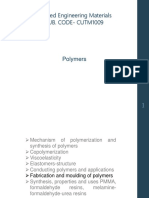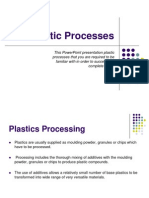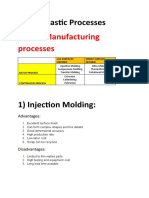Method For Processing of Polymer: Extrusion: Assignment METB 113/1013
Method For Processing of Polymer: Extrusion: Assignment METB 113/1013
Uploaded by
kashvin rajCopyright:
Available Formats
Method For Processing of Polymer: Extrusion: Assignment METB 113/1013
Method For Processing of Polymer: Extrusion: Assignment METB 113/1013
Uploaded by
kashvin rajOriginal Description:
Original Title
Copyright
Available Formats
Share this document
Did you find this document useful?
Is this content inappropriate?
Copyright:
Available Formats
Method For Processing of Polymer: Extrusion: Assignment METB 113/1013
Method For Processing of Polymer: Extrusion: Assignment METB 113/1013
Uploaded by
kashvin rajCopyright:
Available Formats
Assignment METB 113/1013
Method for processing of Polymer: Extrusion
Extrusion is the most common and most important processing method for
thermoplastics. Granules of polymer are fed into the hopper. The screw turns and
drags the polymer along the extruder. Heat from friction with barrel walls, and also
external heat source. The polymer granules are melted and compacted, and the
screw movement also mixes and homogenises the melt. The molten polymer leaves
the extruder through a shaped die which defines the geometry of the products.
Ex:
There are two types of extrusion:
Hot Extrusion:
Generally done at fairly high temperatures, approximately at 50 to 75 % of the
melting point of the metal. The pressures range from 35-700 MPa (5076 - 101,525
psi). To cool down the high temperatures and pressures and its adverse effect on
the die life as well as other components, good lubrication is a must. Oil graphite
and glass powder is preferred as lubricants.
Cold Extrusion:
Cold extrusion takes place at room temperature or slightly elevated temperatures.
This process is useful for withstanding the stresses created by extrusion.
https://www.youtube.com/watch?v=Y75IQksBb0M
Method for processing of Ceramic: Slip Casting
Slip casting is a method for the mass-production of pottery. Slip or liquid clay is
poured into a plaster mold, plaster absorbs water so as it reduces, layers of clay
build up against the inside walls of the mold. When most of the liquid has been
absorbed what remains is poured off. It is left to dry and when drying it shrinks, so
that when opened it is easy to remove. Where the parts of the mold join an uneven
surface will have been left which will have to be trimmed. The product is left to
dry and when dry it becomes what is known as green ware. It can then be
decorated with a transparent glaze or colored slips, the two can be fired together or
it can be fired and then decorated and fired again.
Ex:
https://www.youtube.com/watch?v=M3MTfsx9wWY
Method for processing of composite: Open Molding
In open molding, raw materials (resins and fiber reinforcements) are exposed to air
as they cure or harden. Open molding utilizes different processes, including hand
lay-up, spray-up, casting, and filament winding.
Hand lay-up is the most common and least expensive open-molding method
because it requires the least amount of equipment. Fiber reinforcements are placed
by hand in a mold and resin is applied with a brush or roller. This process is used
to make both large and small items, including boats, storage tanks, tubs and
showers.
Ex:
https://www.youtube.com/watch?v=EhAvCqtIo7w
Spray-up is similar to hand lay-up but uses special equipment—most notably a
chopper gun—to cut reinforcement material into short fibers, add them to resin and
deposit the mixture (called chop) on to a molding surface. Spray-up is more
automated than hand lay-up and is typically used to produce large quantities.
Ex:
https://www.youtube.com/watch?v=0iYnfglPkkU
Filament winding is an automated process that applies resin-saturated, continuous
strands of fiber reinforcements over a rotating cylindrical mold. It’s used for
creating hollow products like rocket motor casings, pipes, stacks, and chemical
storage tanks. Filament winding is less labor-intense than other open-molding
processes.
Ex:
https://www.youtube.com/watch?v=4ihtyjydzqA
You might also like
- Lec 1Document24 pagesLec 1Osama Aadil SaadiNo ratings yet
- Manufacturing Processes: International Islamic University IslamabadDocument44 pagesManufacturing Processes: International Islamic University IslamabadMuhammad Qasim SajidNo ratings yet
- Manufacturing Processes: International Islamic University IslamabadDocument44 pagesManufacturing Processes: International Islamic University IslamabadHassan AliNo ratings yet
- Forming Techniques of PlasticsDocument10 pagesForming Techniques of Plasticsstephennyaosi32No ratings yet
- 202004032240236827nksingh Polymer ProcessingDocument9 pages202004032240236827nksingh Polymer ProcessingMuhammad Umair Akbar GujjarNo ratings yet
- FilmsDocument2 pagesFilmsElisya DiantyNo ratings yet
- Compression Molding Is A Method ofDocument4 pagesCompression Molding Is A Method ofsathishpantaloonNo ratings yet
- Unit 4 (BCHE-602)Document14 pagesUnit 4 (BCHE-602)Garima TamtaNo ratings yet
- Boost ConvertorDocument5 pagesBoost ConvertorFaizan MalikNo ratings yet
- Plasting ProcessingDocument19 pagesPlasting Processingnethumini GunawardanaNo ratings yet
- Homework 4Document2 pagesHomework 4Aditya AgrawalNo ratings yet
- Compression and Transfer MoldingDocument4 pagesCompression and Transfer Moldingjeremybush715No ratings yet
- Plastics FinishingDocument5 pagesPlastics FinishingShaan AbbasiNo ratings yet
- DV02PUB1 Study GuideDocument5 pagesDV02PUB1 Study GuideAnonymous pMVR77x1No ratings yet
- Forming of PlasticDocument25 pagesForming of PlasticAzhar AliNo ratings yet
- Polymer Notes 2014 Parts 8-11 PDFDocument42 pagesPolymer Notes 2014 Parts 8-11 PDFRadhiNo ratings yet
- Methods of Shape Forming Ceramic Powders (SubsTech)Document6 pagesMethods of Shape Forming Ceramic Powders (SubsTech)Ir AyenNo ratings yet
- 2.4 Fabrication Process of PolymerDocument10 pages2.4 Fabrication Process of Polymersalmie_77No ratings yet
- Polymer Processing: ME 318 Manufacturing TechniquesDocument17 pagesPolymer Processing: ME 318 Manufacturing TechniquesSulOgikpcNo ratings yet
- Assignment # 01: Manufacturing ProcessDocument6 pagesAssignment # 01: Manufacturing Processwaqas qadirNo ratings yet
- POLYMER PROCESSING HandoutDocument4 pagesPOLYMER PROCESSING HandoutAmabelle SantosNo ratings yet
- Lecture 13 Processing of PlasticsDocument45 pagesLecture 13 Processing of PlasticsSilentxpireNo ratings yet
- UNIT-4 PlasticsDocument12 pagesUNIT-4 PlasticsDhruv PrabhakarNo ratings yet
- Injection MouldingDocument18 pagesInjection MouldingKishore Steve AustinNo ratings yet
- Chapter 13 - Extrusion-Based Processes (Part 1)Document45 pagesChapter 13 - Extrusion-Based Processes (Part 1)hirenpatNo ratings yet
- Plastic Manufacturing ProcessesDocument6 pagesPlastic Manufacturing ProcessesHimanshu TiwariNo ratings yet
- Olymer Rocessing: The Main Goal of Polymer Processing Is To Produce A Usable ObjectDocument59 pagesOlymer Rocessing: The Main Goal of Polymer Processing Is To Produce A Usable ObjectChaitanya PatelNo ratings yet
- Plastic Moulding ProcessDocument4 pagesPlastic Moulding Processkeerthi939No ratings yet
- Raw Material E-Glass FibberDocument7 pagesRaw Material E-Glass Fibberpramo_dassNo ratings yet
- Processing of PolymersDocument15 pagesProcessing of PolymersK Sruti RaniNo ratings yet
- Pak CipDocument2 pagesPak Cipapril_ian02No ratings yet
- 5.2 Plastics: Called Thermo Sets: 5.2.1 Thermoplastics. Thermoplastics Become Soften When Heated and Hard When CooledDocument4 pages5.2 Plastics: Called Thermo Sets: 5.2.1 Thermoplastics. Thermoplastics Become Soften When Heated and Hard When CooledBereket BlessingNo ratings yet
- Polymer and Ceramic ProcessingDocument43 pagesPolymer and Ceramic ProcessingnvemanNo ratings yet
- Injection Permanent Molding and Extrution Machine: Case StudyDocument7 pagesInjection Permanent Molding and Extrution Machine: Case StudyBrown MeshNo ratings yet
- Moulding TechniquesDocument24 pagesMoulding TechniquesBubbleNo ratings yet
- Processing of PolymersDocument36 pagesProcessing of Polymerssaadahmedkalidaas100% (1)
- Plastic ProcessesDocument27 pagesPlastic Processesnitouch3564No ratings yet
- 1.polymer ProcessingDocument23 pages1.polymer Processingafia rahmanNo ratings yet
- Plastic Moulding ProcessDocument28 pagesPlastic Moulding ProcessQUAZI ADYAN AHMAD 160419736049100% (1)
- Die PressingDocument14 pagesDie PressingAYUSHI MEENANo ratings yet
- Compression MoldingDocument17 pagesCompression MoldingSoloproNo ratings yet
- Transfer and Compression Molding of PolymersDocument4 pagesTransfer and Compression Molding of PolymersMarcoNo ratings yet
- Powder MetallurgyDocument16 pagesPowder MetallurgyMark MactNo ratings yet
- Chapter - Spinning PDFDocument11 pagesChapter - Spinning PDFnaimur.7566No ratings yet
- Gear Type Injection MouldingDocument47 pagesGear Type Injection MouldingJohn Ajish50% (2)
- Thermoplastic and ThermosetDocument8 pagesThermoplastic and ThermosetRenzo Cadag MacasilNo ratings yet
- Compression Molding AbstractDocument2 pagesCompression Molding AbstractFAIZ RASOOL100% (1)
- Plastic Injection Moulding Study GuideDocument5 pagesPlastic Injection Moulding Study GuideChirag PatelNo ratings yet
- Extrusion InformationDocument29 pagesExtrusion InformationNishant1993100% (1)
- Polymers PPT PDFDocument47 pagesPolymers PPT PDFShivani RajeevNo ratings yet
- Advaned Ceramic Forming MethodsDocument24 pagesAdvaned Ceramic Forming Methodsopj662No ratings yet
- Lecture 10 (28-07-2023)Document4 pagesLecture 10 (28-07-2023)skbhayday1No ratings yet
- Types of MoldingDocument33 pagesTypes of MoldingIshfaq SadiqNo ratings yet
- MTP 3 NotesDocument8 pagesMTP 3 Notespratham95213No ratings yet
- Plastic Processes - FINALDocument48 pagesPlastic Processes - FINALswap dNo ratings yet
- Blow MoldingDocument6 pagesBlow Molding2b29bbf9p5No ratings yet
- Aircraft Materials, Construction and RepairDocument20 pagesAircraft Materials, Construction and RepairMark Jovince CardenasNo ratings yet
- Unit4 Part2Document15 pagesUnit4 Part2rr1998773No ratings yet
- Extrusion Molding MethodsDocument24 pagesExtrusion Molding MethodsHartono PrayitnoNo ratings yet
- Revision QuestionDocument4 pagesRevision Questionkashvin rajNo ratings yet
- Data Lab Mesb2014 Temperature MeasurementDocument1 pageData Lab Mesb2014 Temperature Measurementkashvin rajNo ratings yet
- Lab 2 Determing Fluid Velocity and Discharge Coefficient-Converted NewwwDocument11 pagesLab 2 Determing Fluid Velocity and Discharge Coefficient-Converted Newwwkashvin rajNo ratings yet
- 5 6293893424005251564 PDFDocument149 pages5 6293893424005251564 PDFkashvin rajNo ratings yet
- Activity: Welding: MEFB1012/MEFB121 M P L SEMESTER 1 2020/2021Document8 pagesActivity: Welding: MEFB1012/MEFB121 M P L SEMESTER 1 2020/2021kashvin raj0% (1)
- Labsheet Lathe S12021Document7 pagesLabsheet Lathe S12021kashvin rajNo ratings yet
- University Tenaga Nasional: College of EngineeringDocument12 pagesUniversity Tenaga Nasional: College of Engineeringkashvin rajNo ratings yet
- Activity: Milling: MEFB1012/MEFB121 M P L SEMESTER 1 2020/2021Document7 pagesActivity: Milling: MEFB1012/MEFB121 M P L SEMESTER 1 2020/2021kashvin rajNo ratings yet
- Worked SolutionsDocument194 pagesWorked SolutionsMatthew LawrenceNo ratings yet
- 13 Cellular RespirationDocument6 pages13 Cellular RespirationJohnNo ratings yet
- Test Bank For Organic Chemistry 11th Edition by Solomons (Chapter 1) Test Bank For Organic Chemistry 11th Edition by Solomons (Chapter 1)Document64 pagesTest Bank For Organic Chemistry 11th Edition by Solomons (Chapter 1) Test Bank For Organic Chemistry 11th Edition by Solomons (Chapter 1)angelineNo ratings yet
- Green Synthesis of Zinc Oxide Nanoparticles A ComparisonDocument7 pagesGreen Synthesis of Zinc Oxide Nanoparticles A Comparisonm61367366No ratings yet
- Experimental Investigation of Mechanical Behavior of Bau - 2019 - Materials TodaDocument8 pagesExperimental Investigation of Mechanical Behavior of Bau - 2019 - Materials TodaClaudia UngureanuNo ratings yet
- PhotosynthesisDocument19 pagesPhotosynthesisthushyanthNo ratings yet
- Ra 013 D2ra06045kDocument21 pagesRa 013 D2ra06045kRohanNo ratings yet
- United States Patent (10) Patent No.: US 8,822,176 B2Document93 pagesUnited States Patent (10) Patent No.: US 8,822,176 B2M FNo ratings yet
- MCR 321Document11 pagesMCR 321Rishu DeyNo ratings yet
- LESSON 4 MetamorphismDocument3 pagesLESSON 4 Metamorphismjustin charles jerimy raymundoNo ratings yet
- Endapan SkarnDocument40 pagesEndapan SkarnFrans AndersonNo ratings yet
- United States Patent (10) Patent No.: US 9.261,334 B1Document10 pagesUnited States Patent (10) Patent No.: US 9.261,334 B1ibrahim sugarNo ratings yet
- Heterogeneous Fenton Catalyst Supports Screening For Mono Azo Dye Degradation in Contaminated WastewatersDocument8 pagesHeterogeneous Fenton Catalyst Supports Screening For Mono Azo Dye Degradation in Contaminated Wastewatersatina niesaNo ratings yet
- Normality and Molarity 2 PDFDocument16 pagesNormality and Molarity 2 PDFMayra FlorNo ratings yet
- Surface Sciences: Springer Series inDocument415 pagesSurface Sciences: Springer Series inFaidra AmargianouNo ratings yet
- Nano Technology in Water Treatment-1Document10 pagesNano Technology in Water Treatment-1kizito olewuikeNo ratings yet
- Notes Chapter 884Document1,497 pagesNotes Chapter 884notime ReactionNo ratings yet
- Chirality (Multiple Choice) QPDocument11 pagesChirality (Multiple Choice) QPMichael SilaNo ratings yet
- Pierre Dujols de Valois - Chrysopoeia - The Art of Gold Making (2016, Inner Garden Press) - Libgen - LiDocument70 pagesPierre Dujols de Valois - Chrysopoeia - The Art of Gold Making (2016, Inner Garden Press) - Libgen - LiJack Bravo100% (1)
- Acids, Bases and SaltsDocument5 pagesAcids, Bases and SaltsIsa ShahidNo ratings yet
- Application of Some Nanoparticles in The Field of Veterinary MedicineDocument17 pagesApplication of Some Nanoparticles in The Field of Veterinary Medicinesonyatefa22No ratings yet
- E-Waste Characteristic and Its Disposal: M. C. Vats, S. K. SinghDocument13 pagesE-Waste Characteristic and Its Disposal: M. C. Vats, S. K. Singhmadhavi likharNo ratings yet
- CHM2 11 - 12 Q3 0403 FDDocument17 pagesCHM2 11 - 12 Q3 0403 FDJerome ManriqueNo ratings yet
- Fleyfel Et Al.Document18 pagesFleyfel Et Al.demclassychiczNo ratings yet
- Biomolecules - Practice SheDocument8 pagesBiomolecules - Practice Shesray02051No ratings yet
- Earth and Life Science: Quarter 1 - Module 3: MineralsDocument26 pagesEarth and Life Science: Quarter 1 - Module 3: MineralsLerwin GaringaNo ratings yet
- Synthesis Pyridinium ChlorochromateDocument4 pagesSynthesis Pyridinium Chlorochromatemario840No ratings yet
- Lec 1 Introduction To Dental MaterialsDocument38 pagesLec 1 Introduction To Dental MaterialsAbrar AxNo ratings yet
- Redox Reactions Concept, Formulas And: NEET & JEE 2022 Grade 11 ChemistryDocument79 pagesRedox Reactions Concept, Formulas And: NEET & JEE 2022 Grade 11 ChemistryM.DINESHWARAN M.DINESHWARANNo ratings yet
- Su 1975Document2 pagesSu 1975thoriqalf12No ratings yet

































































































